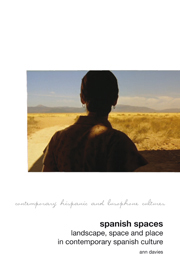Book contents
- Frontmatter
- Contents
- Acknowledgements
- List of illustrations
- 1 Introduction
- 2 Memory: landscapes of the past in Guillermo del Toro's Spanish films
- 3 Forgetting: the landscapes of Gonzalo Torrente Ballester
- 4 Landscape and identities in the Basque Country
- 5 Crime scene: landscape and the law of the land
- 6 Crime, scene, investigation: women, detection and the city
- 7 Coasting: tourism and landscape
- 8 Immigration: north (of) Africa
- 9 Conclusion
- Filmography
- Bibliography
- Index
2 - Memory: landscapes of the past in Guillermo del Toro's Spanish films
- Frontmatter
- Contents
- Acknowledgements
- List of illustrations
- 1 Introduction
- 2 Memory: landscapes of the past in Guillermo del Toro's Spanish films
- 3 Forgetting: the landscapes of Gonzalo Torrente Ballester
- 4 Landscape and identities in the Basque Country
- 5 Crime scene: landscape and the law of the land
- 6 Crime, scene, investigation: women, detection and the city
- 7 Coasting: tourism and landscape
- 8 Immigration: north (of) Africa
- 9 Conclusion
- Filmography
- Bibliography
- Index
Summary
This and the next chapter emphasise one of the key contemporary political and cultural issues in Spain today, that of the recuperation of memories of the Spanish Civil War and its aftermath. Spain's transition from dictatorship to democracy in the late 70s and early 80s was assumed to be based on a pacto de olvido (pact of forgetting) that did not call to account those who played a leading role in the previous Franco regime. In particular, those on Franco's side who committed atrocities against their opponents benefited from an implicit amnesty for their crimes. However, as democracy consolidated itself, more explicit moves were made to remember those who suffered as a result of being on the losing side in the War. In particular, relatives of soldiers and political prisoners who died during the War or its immediate aftermath began to call for the remains of these people to be located and given formal burial. This often entailed uncomfortable acknowledgement of those who were responsible for shooting and giving indiscriminate burial to political prisoners, and resistance began to build against the attempts to recuperate the bodies of family members. Then in 2007 the Zapatero government passed the Ley de memoria histórica that stipulated the cooperation of local and regional governments and councils with the efforts of relatives to track down buried victims, making available records and documents that some governing bodies had hitherto tried to keep hidden.
- Type
- Chapter
- Information
- Spanish SpacesLandscape, Space and Place in Contemporary Spanish Culture, pp. 21 - 39Publisher: Liverpool University PressPrint publication year: 2012
- 1
- Cited by

